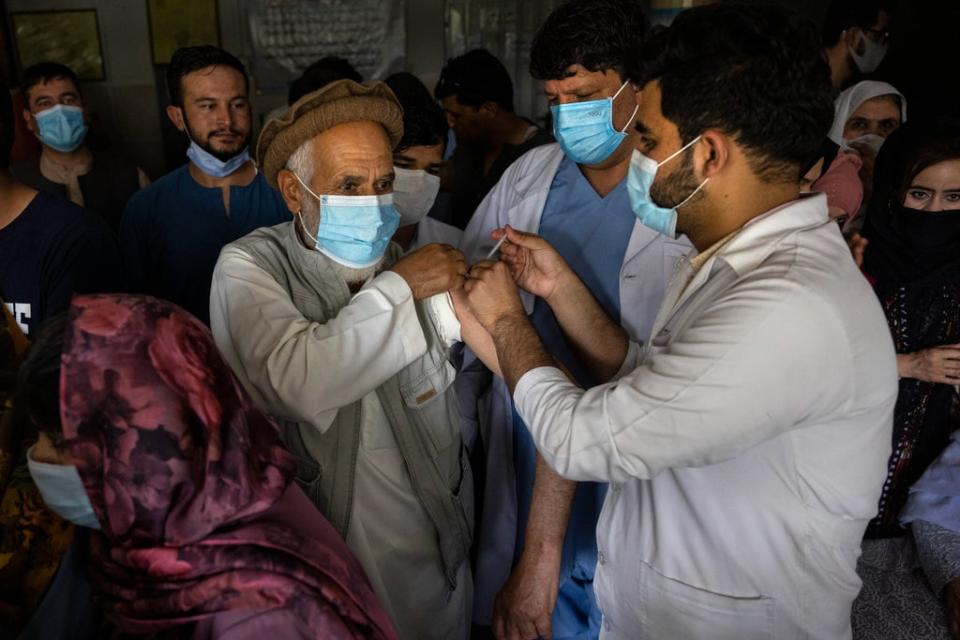Covid: COVAX delivers one billionth vaccine dose in race to vaccinate the world

The COVAX global vaccine-sharing programme has delivered 1 billion Covid-19 vaccine doses to the world’s poorer nations, a milestone reached over the weekend when a consignment of jabs landed in Rwanda.
But there is still a way to go in the struggle for global vaccine fairness: while the UK and other wealthy nations roll out their third dose booster programmes, 40 per cent of the world’s population has yet to receive a first dose.
“Over the course of just one year, a global mechanism set up during an unprecedented pandemic has delivered its first billion doses of vaccine,” said Dr Seth Berkley, CEO of Gavi, the non-profit vaccine alliance that is one of the three principal backers of COVAX.
The shipment of 1.1 million Covid-19 vaccines landed in the Rwandan capital Kigali late on Saturday, including the one billionth COVAX dose. The landmark delivery marks a high point after a tough year for the initiative set up to deliver Covid-19 vaccinations more equitably around the world.

It came up against huge challenges in 2021 in the face of dose hoarding, export restrictions and logistical constraints.
The monumental task of delivering the vaccines has been led by the UN children’s agency UNICEF, which, even before the pandemic, ran a massive global immunisation programme, vaccinating half of the world’s children every year.
“We were able to quite quickly pivot and use that experience and apply it to Covid,” says Joanna Rea, Unicef UK’s Director of Advocacy. “Using the systems and structures that we had in place already for routine immunisations… we made sure they could be used for Covid.
“Things like refrigeration units, supply chains, training staff, making sure that clinics were up and running with the people that they needed. And helping countries to plan the rollout as well, because again, we’ve done that with routine immunisations.”

COVAX was established in the early months of the pandemic with the aim of ensuring that lower income countries had access to vaccines by asking countries to pay into a pot to build a portfolio of doses to be shared fairly.
It struggled to raise funds initially and fell behind national governments in the queue for doses.
“In a supply-constrained world in 2021, wealthy countries were hoarding vaccines and we were not given great transparency from manufacturers,” says Olly Cann, Gavi’s Director of Communications. “We were given the impression that we were not prioritised - even for orders we had paid for with our own money.”
Deliveries that started in February 2021 came to a juddering halt in April when the Indian government blocked exports of the vaccine to deal with its own wave of infections. That cut off doses from the Serum Institute of India, a key supplier expected to provide millions of AstraZeneca shots.
The COVAX rollout ramped up in the summer with donations from the United States, the European Union, China, the UK and others, adding Johnson & Johnson, Moderna, Pfizer and Chinese brands Sinopharm and Sinovac to the menu of doses. In the coming weeks, Novavax and Clover should be added to the mix, says Cann.
Still, donations of vaccines arrived haphazardly, often at short notice and sometimes with doses close to expiry. Donors’ stipulations that doses are allocated to countries selected by them has added to the complexity of the rollout.
By December, some of the supply issues were ironed out and deliveries surged - just as the new variant Omicron struck. “That was a bit of a wake up call, rightly, for countries, and they started sharing more,” says Rea from UNICEF UK.
Predictability of supply is as important as volume. “We finally got clarity for the countries that we serve,” says Gavi’s Cann. “It had been really difficult for countries to plan – you can’t just pick up the phone and say ‘do you want 10 million doses?’”
Gavi is seeking more funds to reach the WHO’s goal of vaccinating 70 per cent of the population in poorer nations by mid-2022.
It is keeping an eye on 20 or so countries, including Afghanistan and Yemen, for which rolling out a new vaccine is particularly difficult. According to WHO, the reclusive Horn of African nation of Eritrea has yet to start administering Covid vaccines.
“The countries that are most challenged are often affected by conflict and have difficulty in keeping up health systems … we need to help them to deliver vaccines and to increase their absorption capacity, ” says Cann.
Meeting the 70 per cent target would require a huge acceleration of dose sharing and support for low-income countries to then get the vaccines into arms, “otherwise, this time next year we’ll be in the same situation with a new variant, a potentially more lethal variant, taking us all back to square one,” says Rea of UNICEF.
“So a billion doses is something to celebrate, it’s a great milestone, but we have a long way to go.”

